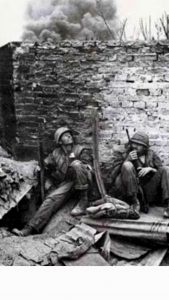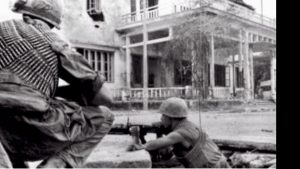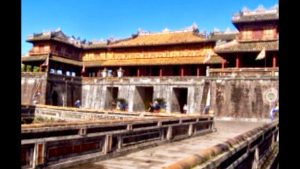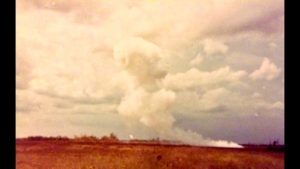*Although the Battle of Hue City was one of the bloodiest of the Vietnam War scenarios similar to this one played out hundreds of times throughout Vietnam. Young American men trained to fight and survive dealt with death as a daily routine and sometimes it became just another day at the office.
HUE (pronounced whey)
Hue is the intellectual, cultural, and spiritual heart of Vietnam. Sitting on the northern bank of the Perfume River (Song Huong River) it is a World Heritage site boasting the grand Citadel built by ancient emperors in 1802. Hue, the original capital, remained the heart of Vietnam until the Potsdam Aggreement in 1945 when Vietnam was divided at the 16th parallel.
According to the agreement China would control the north and the British would control the south while France getting back on its feet after WWII returned to reclaim the territory it lost during the war. Throw in the Viet Minh government of Ho Chi Minh in Hanoi and Hue City, just south of the dividing line, is in total disarray. Ho claimed Hanoi in the north to be the new capital of Vietnam while Diem his counterpart inserted and backed by America claims Saigon to be the new capital in the south. Hue City unseated as the capital is now a city without an identity.
The 1968 Tet Offensive was some of the bloodiest fighting of the war and the Battle of Hue City was the bloodiest fighting of the Tet Offensive. It’s historical and religious significance was secondary to it’s military importance. The US’s MACV (Military Assistance Command Vietnam) and South Vietnam’s ARVN (Army of the Republic of Vietnam) both had their headquarters located within the city. Strategically located just south of the DMZ (demilitarized zone) on the Perfume River and close to the South China Sea it was a prime target for a major attack.
On January 30,1968 intelligence received information of impeding attacks on cities south of Hue and preparations were made to head in that direction. Undetected elements of the Vietcong’s 12th Unit and Hue Sapper Battalions slipped into the city during the night and made preparations for an offensive. The following morning under the cover of dense fog a battalion of the People’s Army of Vietnam, (PAVN) or North Vietnam, were advancing from the west and were within attacking distance. Hue City was under siege.
ARVN units were first to be attacked by rocket fire as two additional PAVN units attacked from the northwest and the southeast. The objective was the Citadel in the north part of the city and the US’s MACV headquarters in the south. By days end the Communists held most of Hue south of the river and the southern half of the Citadel. That night the Vietcong hoisted their flag in the Citadel, known as the Palace of Peace, they claimed the city as their’s. Surrounded by the communists 200 Americans and Austalians held on in the MACV compound while the ARVN’s held the north half of the Citadel.
The US Marine Base at Phu Bai, the closest to Hue, received the distress call and responded but was a long distance away and a considerably small unit for this operation. Reaching the city they were beaten back for several days as additional units were deployed. The 1st Marine Division continued to send units piecemeal but failed to clear the city as the Communists advanced.
Hue jail held 2500 prisoners which were released by the communists adding 500 more fighters to the attacking forces. A weapons depot stockpiled with American munitions also fell fortifying these additional fighters. In addition the A Shau Valley lines were still open assuring that the attackers were well fortified. Eventually five more battalions were added to the nine already in the city.
General Westmoreland believing the Communists would attack Khe Sanh underestimated the attack on Hue and was reluctant to use air power to aid the Allied Forces. Siting the nature of close urban fighting and the desire not to damage the historical significance of the Citadel he was sidelined by the onslaught. After almost two weeks of bloody fighting the ARVN commander ordered whatever air power necessary to sever the Communist attack. Air strikes followed his orders destroying many historical landmarks.
Simultaneously US 1st Air Calvary began air assaults on landing zones six miles northwest of the city to cut off supply routes as additional units landed to the west trying to link up. Both units were repelled for a week. Westmoreland now committed additional battalions as more 1st Air Calvary and 101st Airborne units from Khe Sanh flooded the city. The Marines continued to send in units and eventually crossed the river and joined the ARVN forces. The enemy held on and the fighting continued for two more weeks from house to house and for the first time in the war both sides used tear gas. On February 25, 1968 the 1st Calvary closed off the Communists supply line from Khe Sanh and the ARVN cleared the Citadel. The Battle of Hue City was over but not without leaving a tragic legacy.
The Allied forces unearthed the first of the mass graves left by the Communist onslaught as a systematic slaughter of civilians was taking place during the occupation. Searchers found 2,810 bodies in mass graves carried out by Vietcong cadres and thousands more remained missing. Scholars believe that as many as 5,700 innocent civilians were murdered in that one month of fighting.
STATISTICS:
Allied Forces
600 dead
3,194 wounded
Communists
5,000 dead
89 captured
Civilians
116,000 homeless
out of 140,000 residents
countless died in the fighting
possibly 5,700 murdered
50% of the city completely destroyed
Soldiers pinned down are waiting for help.

Fighting from house to house destroying the city one building at a time.


The Grand Citadel held by the Communists, the center for religious and spiritual Vietnam, was heavily damaged. At one point the Vietcong raised their flag over the Citadel and declared the city theirs.

*Although the Battle of Hue City was one of the bloodiest of the Vietnam War scenarios similar to this one played out hundreds of times throughout Vietnam. Young American men trained to fight and survive dealt with death as a daily routine and sometimes it became just another day at the office.
The hardest part of a night ambush was finding the right spot to set up. If the area was to open we would be spotted but if there was to much foliage we would be confined without escape. We decided on an open situation close to a woodline offering us a backup plan for retreat. Intelligence suggested there were Vietcong in the area so our coordinates were adjusted for that purpose. We were a considerable distance from the main unit for a six man team to operate but there we were setting up for the night. Doling out guard duty randomly we spread out over a considerable distance so one well placed blast wouldn’t take out more than one of us.
The stars were visible and it was one of those beautiful Vietnam nights broken only by the sound of rumbling in the distance. Thinking of a hot dry summer night back home, the kind with thunder and lightening but no rain, I made comparisons yet I knew better. This all to familiar sound of thunder and lightening were bombs and battles relentlessly raging night after night. Like background highway traffic noise that’s always there you get used to it.
At one end of this line we called a perimeter Peter and I laid out our equipment and I pulled the first two hour guard duty shift while the others rested. Being on my feet all day humping or fighting I was always tired and sitting perfectly still and staying awake was difficult. My eyes began playing tricks on me as I rubbed the sleep out of them. I began imaging I saw things then they disappeared and so the night went on. Rubbing my eyes again I saw people walking across the field perpendicular to us so I woke Peter.
Peter and I were childhood friends in Bay Shore New York and after graduation we joined the Army together. The draft was coming and it was either that or a two year enlistment on the Buddy System. Why wait for the inevitable we thought so we joined. Together in basic and later in advanced training we now found ourselves sitting in the dark on a night mission. Always together, we jokingly told everyone we were cousins.
Opening his eyes, Peter saw the same appiritions and they were getting closer. The signal went down the line until all were on alert. On lead we knew no one would make a move without us so we watched these figures meandering across the field as we held our breath and waited. Getting closer they approached a fork in the path and began turning away. Rather than lose them Peter opened up with his M-16 and two fell immediately, I followed and a third hit the ground. Having the element of surprise was on our side and the remaining Viercong took cover in the woodline. Soon all went quiet again and returned to a peaceful Vietnam night accompanied by the rumbling in the background.
I was up for the rest of the night and sitting in the same position as daylight broke. I could now see the result of the previous night as Peter and I recorded our first kills. We called it in and headquarters sent a team out for the extraction of the bodies as we prepared for another mission. In that team was an embedded reporter from the Daily News. Delta had a reputation as the “go to guys” but in the unit we were known as the New York cousins. When the reporter heard about us he wrote this story and on April 28,1969 this article hit the New York papers.

The average age of a Vietnam soldier was 19 years old as compared to WWII which was 26. That means some men in Vietnam were 21 and some were 17. Sid, one of our six man team, went in the Army at 17 years old.
Fighting and killing was our job, weither it was the Battle of Hue City or a night ambush, we were programmed to kill and we treated it as another day of work. The indifference and cheapness of life during war removes us from the reality of the situation. To survive emotionally we had to be indifferent to the act of killing or convince ourselves of a false sense of reality. We were right and they were wrong about what we didn’t know but thats the way it was. The strange part about killing is the false sense of righteousness instilled in us. We carried it with pride. At the time I killed I didn’t question my motives I just assumed it was right and so I performed my job. It got me through each day.
Feelings come into play when a fellow soldier is killed or voporized by a bomb but only in retrospect. I tried not to get to close to anyone because they might not be there tomorrow. Only in the case of Peter would it have made a difference if he were killed. A dead soldier is sacred but in the grand scheme of things we fight and forget and the remembering comes later.
A few days after our first kills we worked an area heavily fortified with munition caches and booby traps. It was a duel ambush mission with our sister squad and we discussed the set up arrangements before we left. Take the high road or the low road it didn’t matter, we went one way and they went the other knowing we would be in constant visual contact. Unfortunately it did matter. Our sister squad set off a land mine and several men were vaporized right before our eyes. We watched in disbelief knowing it could have been us.
I don’t remember their names because it was the nature of our business. The game of life with a fine line as a buffer zone between fantasy and reality gets us through our surreal adventures of each day. There will be enough time later for the reality of it all, today we have work to do.
Good days followed bad days in Vietnam. I took this picture knowing that in the cloud of smoke lie dead Americans as we watched helplessly to our sister unit perish.

